
At last we had reached the start of the 120-mile Gota Canal itself, at the village of Mem. The gates of the first of its 58 locks opened as we approached, and the Diana was carefully steered in. She was a snug fit; there was about a foot of clearance on the width of the lock and about the same on the length, and one of the crew members jumped ashore to run ahead and indicate to the captain the distance from the bows of the ship to the cill of the lock. We found out that the name given to the crew member who performs this function is called the "jump-ashore Johnny" even when the crew member concerned is a young female.
Soderkoping is the first sizeable town on the canal. The ship stopped there to let us spend the sunny afternoon exploring on shore, and it was here that we gained an idea of the importance of our ship on the canal as it moored in the half-filled lock to make it easy for us to get on and off. It stayed in the lock for the rest of the afternoon and all other craft just had to tie up and wait until we chose to depart! Soderkoping is a very pretty little town, with a beautiful church which like most ancient Swedish churches has a most impressive, separate wooden bell tower.
 |
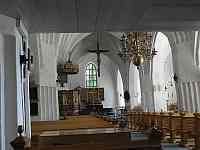 |
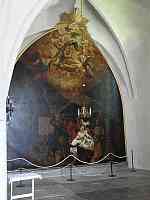 |
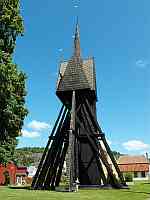 |
The beautiful church at Soderkoping |
Inside Soderkoping church ... |
... there are beautiful paintings on the walls |
The wooden bell tower is separate from the church |
Soderkoping is also famous for its ice-cream, which is why its name sticks in my mind (ice-cream soda shopping); there is a restaurant near the lock which sells the most amazing ice-creams, and as we queued to buy a couple of simple examples to eat beside the canal I took pictures of the incredible creations which were being delivered to people at the tables.
On the road that ran beside the canal there was a sign "Beware, rabbits crossing" and near to it there was a sculpture of rabbits waiting to cross the canal. Is this a key to the Swedish sense of humour?
 |
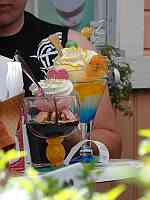 |
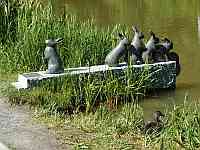 |
 |
Ice creams on the table at Soderkoping |
Rabbits queuing to cross the canal |
There was an accident at Soderkoping in 1931 |
|
The other passengers joined the ship at the lock which was then filled; the "Jump-ashore Johnny" climbed back on board and the ship set off without us, as we had decided to walk alongside the ship to the next lock which was only half a mile away. On the way we watched as it passed trough the lift bridge, causing a quarter-mile queue of traffic, and chatted to another crew member who joined us on his bike after he had been shopping in the town for fishing hooks and light-bulbs.
After Soderkoping there is a busy flight of locks. As we ascended, there were boats of all types following us and coming the other way. There was obviously no shortage of water as it was flowing freely over the gates, but this caused no problems as the locks were all power-operated by lock-keepers. The ship's captain told me that no exceptions are made, even for his ship: ship owners are not allowed to operate the locks or bridges themselves, and when the lock keepers go off duty all traffic must stop. Just two or three locks are still manually operated, and these are all stop-locks whose rise or fall is very small, but passage even through these is not permitted if a lock keeper is not present.
Soon after ascending the flight near Soderkoping we reached a small rolling bridge. During the journey we passed through several of these bridges, which roll back along their own road on a set of small wheels; most of them were operated remotely by the keeper at the nearest lock. These pictures and the short video illustrate their mode of operation.
This video clip, just over 30 seconds long, shows the bridge closing behind us:
This video clip, just over 30 seconds long, shows the mechanism being operated:
As you can see, the person operating the gates has to walk a long way to open the gates. For large or stiff gates, it can be seen that there was the capability to add a second lever so that a second person could help turn it. The cargo boats on this canal were apparently usually operated by a husband and wife team, but it was such hard work that it was nicknamed the "Divorce Ditch".
As evening fell, we crossed the beautiful lake Roxen, 100ft above sea level, and it was getting quite dark by the time we moored on the far side of the lake, at the foot of the impressive 7-rise staircase there. The approach to the mooring was marked by a giant statue, made of perforated metal (presumably to reduce its wind-resistance) which gave it a strangely ethereal quality.
The next morning was again fine and sunny, and we were offered the opportunity to swim in the lake. Did we take the opportunity? You'll have to read the next page to find out
All pictures on this site are © Allan Jones unless otherwise stated